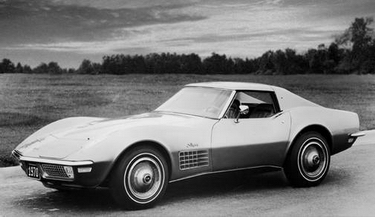Vette News - Corvette: Milestones & More - C3
Over its 60-odd-year run, the Corvette has largely stuck to its original objective of providing homegrown performance wrapped in a stylish, two-seat package. Its journey has at times been an uncertain one, but now in its seventh generation, it's safe to say the hits have outnumber the misses. Here's our look at the Corvette story from conception to the C7. This is article three in a series of seven.

C-3: 1968 - 1982
1968: Sculpted to resemble the Mako Shark II show car of 1965 and offering a 435-hp, 427-cubic-inch
(7.0-liter) engine, the third-generation Corvette starts a 14-year run on what is essentially a carry-over chassis.
The '68 debut ushers in that '70s sun-seeker's savior, the T-top, although full convertibles are still on the menu.
The battery is moved to a compartment behind the seats, and the ignition switch makes its last appearance on the dash
until 1997. Our 1968 road test calls it the "Barbarella of the car-maker's art."
1969: The 250,000th Corvette, a gold 1969 convertible, rolls off the line on November 19. Only two buyers
opt for the ZL1 all-aluminum big block V-8; priced at $4,718.35, the ZL1 option is only $62.65 shy of the base Corvette
Coupe's base price. The Stingray name returns to the car in the form of scripting above the fender louvers, and it is
one word as opposed to the C2's "Sting Ray."
1970: The 390-hp solid lifter LT1 small-block debuts, and the big-block grows to 454 cubic inches from 427.
The ZR1 factory-racing package arrives and fender flares are added.
1971: All Corvette engines were designed to run on the new unleaded fuel, and the LS6 big-block 454 V-8
engine option is introduced.
1972: A factory-installed theft-deterrent system becomes standard, and the first-gen LT1 gets ready to be put out to pasture.
1973: A body-colored, 5-mph-crash-compliant plastic nose replaces the sleek chrome unit. Radial tires become standard.
1974: The last year for the 454 big-block, and the pair of stylish rear chrome bumperettes are replaced by a body-colored
plastic blob, offending purists.
1975: The final year for the convertible until its 1986 return, and the first year a government-mandated catalytic converter
is fitted. The stock 350-cubic-inch V-8 produces a depressing 165 horsepower, the L82 "performance" engine managing 205.
1976: An over-the-radiator, carburetor air-induction system-designed to reduce noise, as air was previously drawn
under the hood near the windshield-is a new standard feature, and a partial steel underbody is added to add strength and
increase shielding from exhaust heat.
1978: The 25th year of Corvette production is marked by a new fastback body style, and the traditional crossed-flag
emblem is replaced with a special anniversary emblem. "60 series" tires-referred to as "low-profile," laughable by today's
standards-are offered for the first time. An AM/FM stereo with integrated CB radio is offered as an option at the 10-200
inducing price of $638. More than 6500 buyers inexplicably drop an extra $4301.32-over the car's $9351.89 base price-for a
two-tone silver Indy 500 Pace Car Replica edition. It is among Chevy's initial forays into limited-edition Corvettes, but
certainly not the last. (Read our history of special-edition Corvettes.)
1979: Chevy sets an all-time Corvette sales record, peddling 53,807 of the comparatively gutless wonders during the
1979 model year, likely due to all the hoopla over the standard for '79 AM/FM radio. Halogen headlamps become available for
the first time.
1980: New front and rear plastic bumper caps with integrated spoilers and a new hood improve claimed drag coefficient
from .503 to .443 compared to '79 models, and a new aluminum diff housing and crossmember are used. GM doesn't bother to certify
the 350 V-8 for California, so Cali-bound Vettes make do with a 305-cubic-inch V-8.
1981: Corvette production begins in Bowling Green, Kentucky, on June 1; St. Louis production ends August 1. During the
two months of simultaneous production, St. Louis continued to use lacquer-based paints, while Bowling Green used enamels with
a clear coat, which later causes a bit of confusion for restorers. The fiberglass-reinforced rear monoleaf spring appears for
the first time on automatic-equipped cars, weighing in at 36 pounds less than the steel unit it replaced.
1982: To commemorate the last year of C3 production, Chevy built 6759 Collector's Edition Corvettes, all with bespoke
silver and beige paint and an opening rear hatch. Total production for the year was 25,407 units. 1982 was also the last year
for the optional in-dash 8-track tape deck, which followed elephant bells, feathered hair, and male jumpsuits into the dustbin
of history.
1983: As they say on ESPN, it was a rebuilding year. Although no 1983 model-year Corvettes were officially built,
43 prototypes of the upcoming 1984 model were assembled in Bowling Green, and are sometimes referred to as "1983 models." The
750,000th Corvette (a 1984 C4) is produced on October 26, 1983.
Credits: Internet article/series by Andrew Wendler and Kevin Wilson